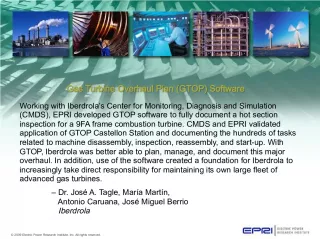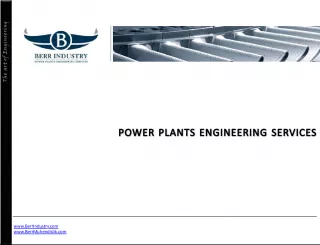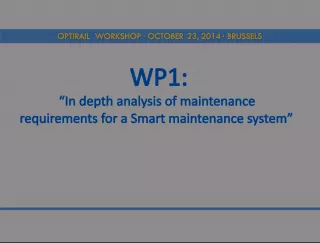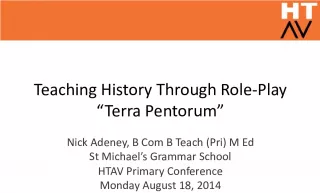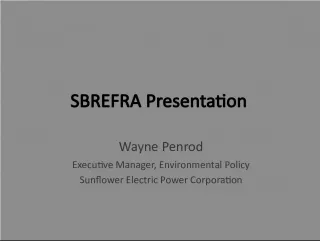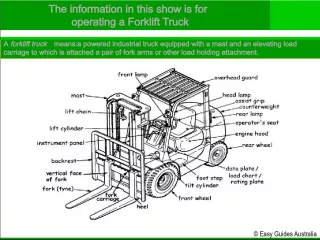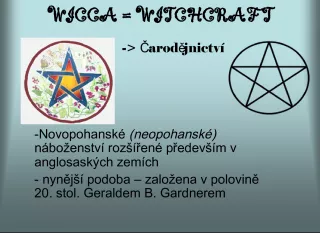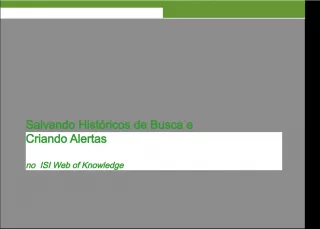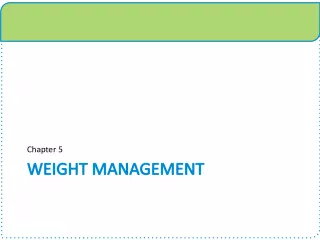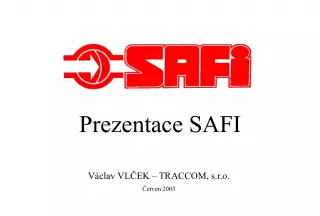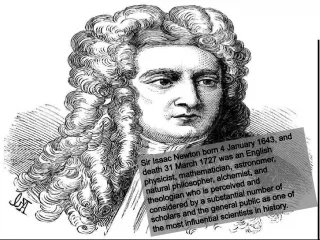Steam Turbine Generator Maintenance and History


This article covers the importance of steam turbine generator maintenance and provides historical statistics on its use in electricity generation.
- Uploaded on | 1 Views
-
 delicia
delicia
About Steam Turbine Generator Maintenance and History
PowerPoint presentation about 'Steam Turbine Generator Maintenance and History'. This presentation describes the topic on This article covers the importance of steam turbine generator maintenance and provides historical statistics on its use in electricity generation.. The key topics included in this slideshow are steam turbine, generator, maintenance, history, electricity generation,. Download this presentation absolutely free.
Presentation Transcript
1. 2012 ARIPPA Technical Symposium 2012 ARIPPA Technical Symposium Steam Turbine Generator Maintenance for Optimized Availability David Branton, CEO Turbine Generator Maintenance, Inc .
2. Steam Turbine Generators some statistics and history 80% of all electricity in the world is generated by steam turbines driving electrical generators: 10,632 TWH [terrawatt (10 12 ) hours] World 3,244 TWH U.S. 1,485 TWH China (expected to be 6,560 TWh by 2030) The first practical steam turbine generator was designed and built by Sir Charles Parsons in 1884 and generated 7.5 MW. Generation principles remain the same. GEs first production steam turbine generator was introduced in 1901 and was rated at 500 KW; just two years later a 5000 KW unit went into commercial service for Commonwealth Edison.
3. Designing a Maintenance Plan Qualitative Tools Running Assessments Periodic Minor Inspections Objective Based Major Inspections Requirements Maximum unit availability No unplanned outages Predictable maintenance costs Options Maximum efficiency Maximum power output
4. The turbine and generator are the largest single investment in a fossil power plant and in many manufacturing and refining facilities. Proper maintenance is required to maintain efficiency (cost of production) and availability (the amount of time the unit is able to operate). Efficiency issues Steam leakage into the environment Steam path steam leakage Blade/nozzle erosion/deposits Availability issues Lubrication failures Steam path failures Control system malfunctions Protective device malfunctions Maintenance Issues
5. Maintenance Planning Maintenance planning considerations Steam pressure/temperatures Type of duty cycle Speed of turbine and generator Extraction, backpressure, condensing considerations Over temperature/pressure operation Environment of facility Quality of water/steam Expectations of plant There is no one size fits all maintenance plan.
6. Maintenance Planning Maintenance planning considerations Major inspections provide opportunities for availability and efficiency improvements with minimum outage impact if planned properly. Major Inspection outages can be better scheduled with qualitative rather than subjective data Availability of the turbine and generator and reliability of critical auxiliaries can be optimized: Periodic Running Assessments combined with data trending and analysis Periodic minor (3-5 day) outages to inspect critical areas for issues A combination of Running Assessments and Focused Minor Inspections can assure availability and optimize major inspections.
7. Turbine Generator Maintenance Outage Cycle
8. Running Assessments Critical parameters Vibration/Noise Turbine inlet temperature fluctuations Stage performance Steam chemistry Bearing temperatures Pedestal expansion/lubrication/cleanliness Electrical system grounding Motor loading Gland system integrity Air in-leakage Lubrication backup integrity Lubrication cleanliness Overspeed protection Generator partial discharge and rotor flux probe Data must be monitored, collected, trended, analyzed, and used for outage planning
9. Running Assessments - Vibration Trending
10. Running Assessments Grounding Brushes Turbine Availability issue
11. Running Assessments Oil System Integrity According to the International Association of Engineering Insurers The highest frequency of turbine generator failures in the 10 400 mw range has been lube oil incidents Dirt and/water contamination Loss of oil pressure
12. Running Assessments DC Backup Turbine Availability issue
13. Running Assessments Generator Rotor Windings Shorted Turns in Pole A - Coil 5, Pole B - Coils 6 and 7 Magnetic Wedges in Coil 1 note small signal
14. Minor Inspection Scopes Bearing Inspections every two years Critical inspections for availability Standard Scope should include Coupling alignment checks Disassembly and inspection of thrust bearing - including total rotor travel and thrust clearance Disassembly and inspection of journal bearings - including UT and LPT Oil system including the oil reservoir, pumps/motors, oil coolers Maintenance oil flush Backup oil system integrity Turbine shaft grounding maintenance Check and calibrate protective devices including overspeed, bearing temperatures and vibration Generator borescope and electrical tests
15. Minor Inspections Bearing Inspections
16. Uneven wear Varnish deposits
17. Minor Inspection Electrical Discharge through the Thrust Bearing
18. Minor Inspection Scopes Valve inspections every two years Critical inspections for safety, efficiency, and control Standard Scope should include: Disassemble, clean, and inspect steam side - Include all stop and control valves - Include all non return valves - Seat integrity and contact - Stem and stem seal integrity Disassemble, clean and inspect control side Check valve set points and travels Perform protective systems inspections and calibration checks Perform borescope inspections of steam inlet/nozzle Perform generator borescope and maintenance tests
19. Minor Inspections Valve Inspections
20. Minor Inspections Valve Inspections Minor Inspections Valve Inspections LP Governor valve seat damage
21. Proper planning can significantly reduce planned outage inspections. Based on the turbine configuration, a major inspection can be completed in 2 6 weeks based on unit size. The turbine-generator is almost always the critical path, and any generator maintenance/repair must be placed in the same outage window. Factors critical to achieving minimum outage durations: Planning for the outage should begin after the last major inspection and developed over a maintenance cycle of Running Assessments and Minor Inspections. Most turbine and generator replacement parts can be sourced from non-OEM suppliers with less lead time. Develop contingency repair plans identify potential scopes of work, identify repair resources, and develop repair schedules. Contract experienced turbine generator teams that understand the unit and have the skills and tools necessary to handle the anomalies and with minimum impact to the schedule. Outage Implementation Major Inspections
22. Major Inspection Findings Averting Forced Outage HP Turbine Nozzle box movement First stage rotating buckets Nozzle migration Turbine wheel corrosion LP Turbine Last row blade migration Generator Rotor winding short Stator core overheating
23. Major Inspection Steam Path Heat shield weld failure in stage 4
24. Major Inspection Steam Path Locking pin failure in rotating stage 1
25. Major Inspection Steam Path Missing seals
26. Major Inspection Steam Path Nozzle migration downstream
27. Major Steam Path Last row blade migration
28. Downstream side Upstream side Major Inspection Steam Path Curtis stage severe damage
29. Steam Turbine Design Types Advantages and Disadvantages Reaction vs. Impulse Reaction designed turbines start out at a higher efficiency less leakage Impulse design turbines have fewer stages Tip Leakage Root Leakage Fig. C-F. Reinker, J.K., and Mason, P.B., Steam Turbines for Large Power Applications, GER-3646D, GE Power Systems, Schenectady, NY.
30. Major Inspection Steam Path Stage efficiency improvement
31. Major Inspection Steam Path Boiler carryover
32. Major Inspection Steam Path Boiler carryover
33. Major Inspection Steam Packing Excessive clearances
34. Major Inspections Generator Stator and core
35. Major Inspection Generator Rotor winding
36. Major Inspection Implementation Outage duration for a major inspection can be optimized by: Effective planning contingency plan development, safety plan, quality plan Team implementation daily reporting and proactive management Pre-Qualified personnel professional, resumes, down to working level Defined and organized tools
37. Steam turbine generators are rugged and with a comprehensive maintenance program can operate reliably. Using proper assessment techniques and performing strategic minor inspections, Major Inspection intervals can be optimized and performed predictably and cost efficiently. Proper operation is imperative to maintain the equipment performance but when anomalies occur, the potential impact must be assessed. A tailored maintenance program can greatly reduce operating costs by maintaining efficiency, availability, and reliability. A planned and well organized outage plan/team can assure on-time outage duration. Conclusions
